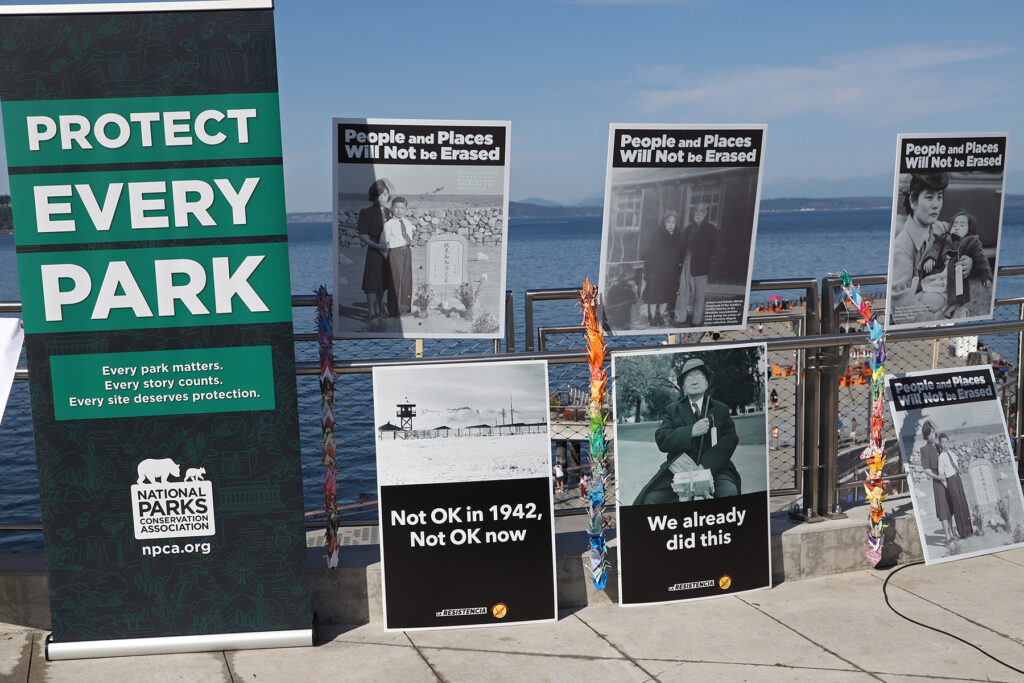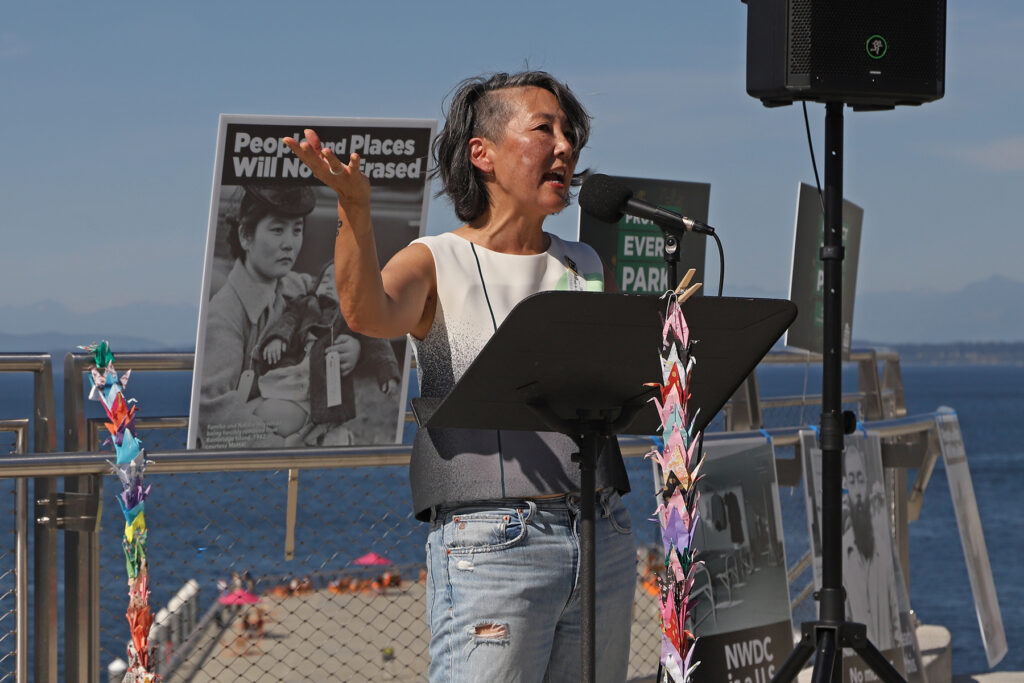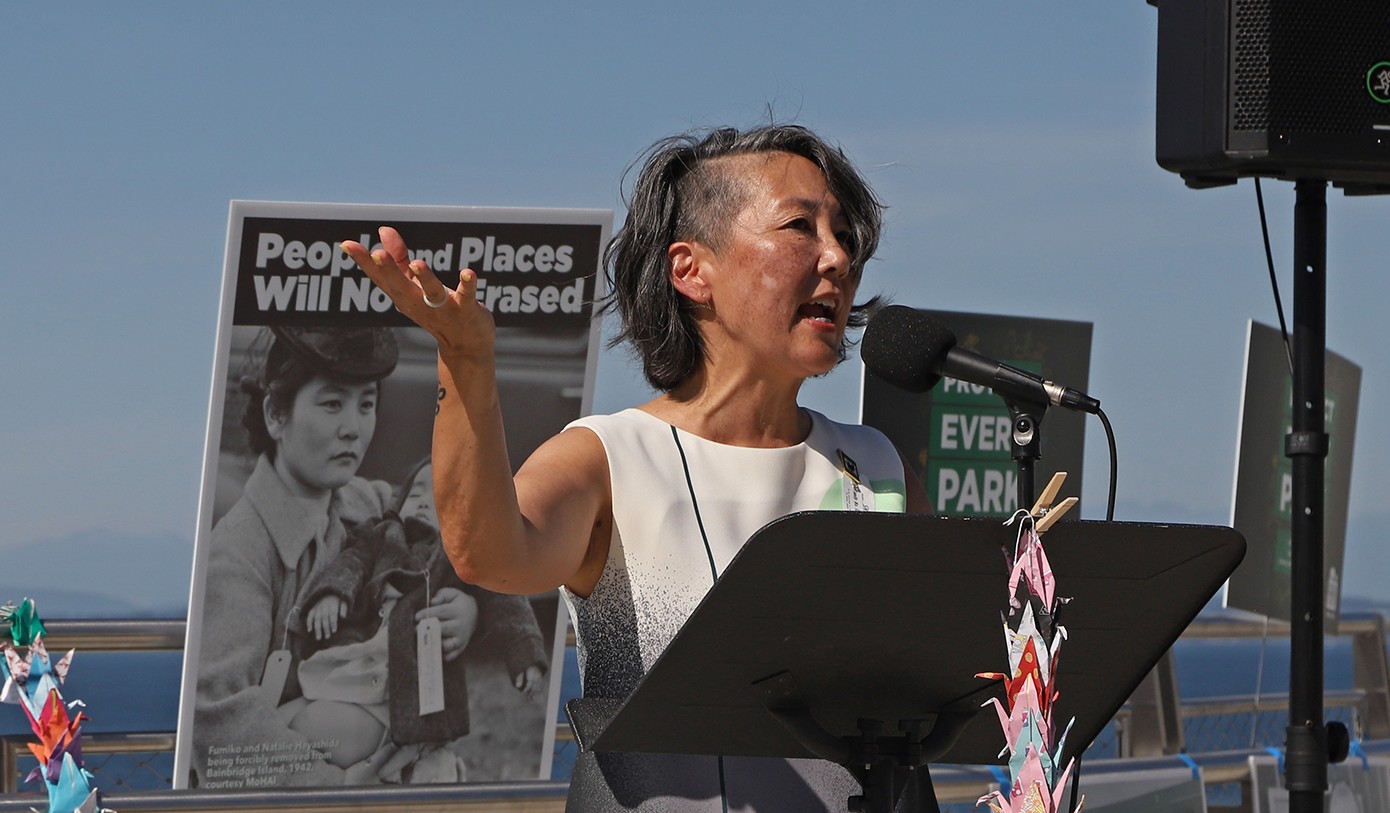September 10, 2025
On August 23, people across the country came together for a day of action to Protect Every Park, standing united against attempts to erase marginalized histories like Japanese American WWII incarceration from our National Parks. Artist and advocate Erin Shigaki spoke powerfully at Seattle’s day of action about the importance of healing from the past, holding onto our collective history, and fighting to put those lessons into practice today. We share her speech here as part of our mission to uplift community voices.
My father and his three siblings grew up in a little yellow house in Seattle’s Central District, which was the same one that my sisters and I based our social lives from as we were growing up. And I didn’t realize until I was much older how remarkable it was that my family had a place to return to, no matter how humble, after three-and-a-half years jailed in the Minidoka concentration camp. My grandmother Yasuko bore witness to her elderly parents’ imprisonment, cared for her husband who descended into mental illness while imprisoned, raised two toddlers and even bore one child with the help of a horse veterinarian while imprisoned.
My family returned to Seattle despite being unwelcomed, but a white friend had looked after the little yellow house. They had a place to land. My grandmother became the PTA President when her children were at Garfield High School. She taught and eventually became the principal of the Japanese Language School that her father had helped to build. She held onto both her American-ness and Japanese-ness — after the attempted cultural genocide of the US government. She returned to heal, to hold both sides of herself and her people, and to fight for her family’s future.
When I was in the 8th grade, fixating on the poverty of the single paragraph about the Japanese American incarceration in my school textbook, my parents, who had learned nothing about these travails, encouraged me to ask my grandmothers. And they spoke. These were the first conversations that put me on a path to heal, hold these fragmented stories, and fight to keep this history alive.

In 1988, Japanese Americans won hard-fought reparations and an apology from the US government. This lifted some of the shame and provided mental space for a return to the scene of the crime. The Minidoka Pilgrimage was born with our goals to heal, hold, and fight.
We just finished our 20th Pilgrimage on the hallowed ground that is now the Minidoka National Historic Site. It is a place where many learn this history for the first time. It is immersive and filled with very personal stories and parts of us. We are extremely grateful to the NPS staff and local efforts that have shepherded the site’s growth over the years. Indeed, the National Park designation of this and other sites of WWII incarceration are also part of our reparations. We return to Minidoka to convene with our ancestors, ask questions, grieve, and to find one another again. We return to heal from the past, hold each other in the present moment, and fight for our collective future.
In my community, I know that there is still more personal healing to do — intergenerational trauma is very real. You don’t have to tell me — a person whose art about our community has been censored and vandalized over and over. However, the only way to break the US government’s repeating patterns of racism and xenophobia is to heal, hold, and fight for both ourselves, and for others.
That means standing up right now with groups like Tsuru for Solidarity for migrants facing the same treatment we did in 1942.
That means letting our elected’s know that we have learned from the National Parks sites that tell our stories, and that we demand an end to repeating cycles of state violence.
Stop disappearing people and families. There are 16 instances in Washington State alone that Angelina Godoy of the University of Washington’s Center for Human Rights has found. Shut down the Northwest Detention Center! Stop flying deportation flights in and out of taxpayer-supported King County Airport!
You don’t have to start anything from scratch or do anything alone. But you do have to be bold, and stay engaged, stay brave. Take care of each other and yourselves. And please show up to heal, hold, and fight.
—

Erin Shigaki is a Yonsei Japanese American artist, activist, and story keeper, born and raised on the Coast Salish land of Seattle, Washington. She creates work that is community-based and focused on the experiences of Black, Indigenous and People of Color and believes that telling these stories can educate, redress, and incrementally heal. She organizes with Tsuru for Solidarity and the Minidoka Pilgrimage Planning Committee, among other community groups. Erin holds a B.A. from Yale University.
Densho publishes guest opinion essays that draw meaningful connections between this history and the present, and that promote equity and justice today. Learn more about our work and mission here.
